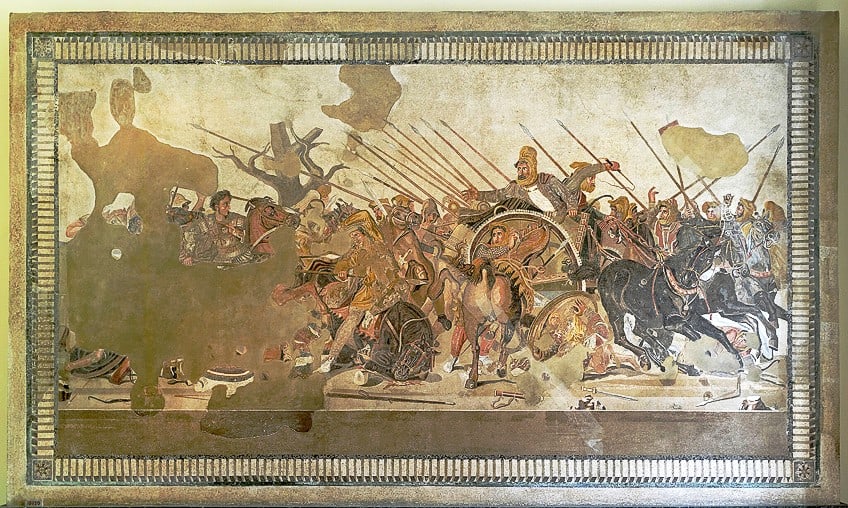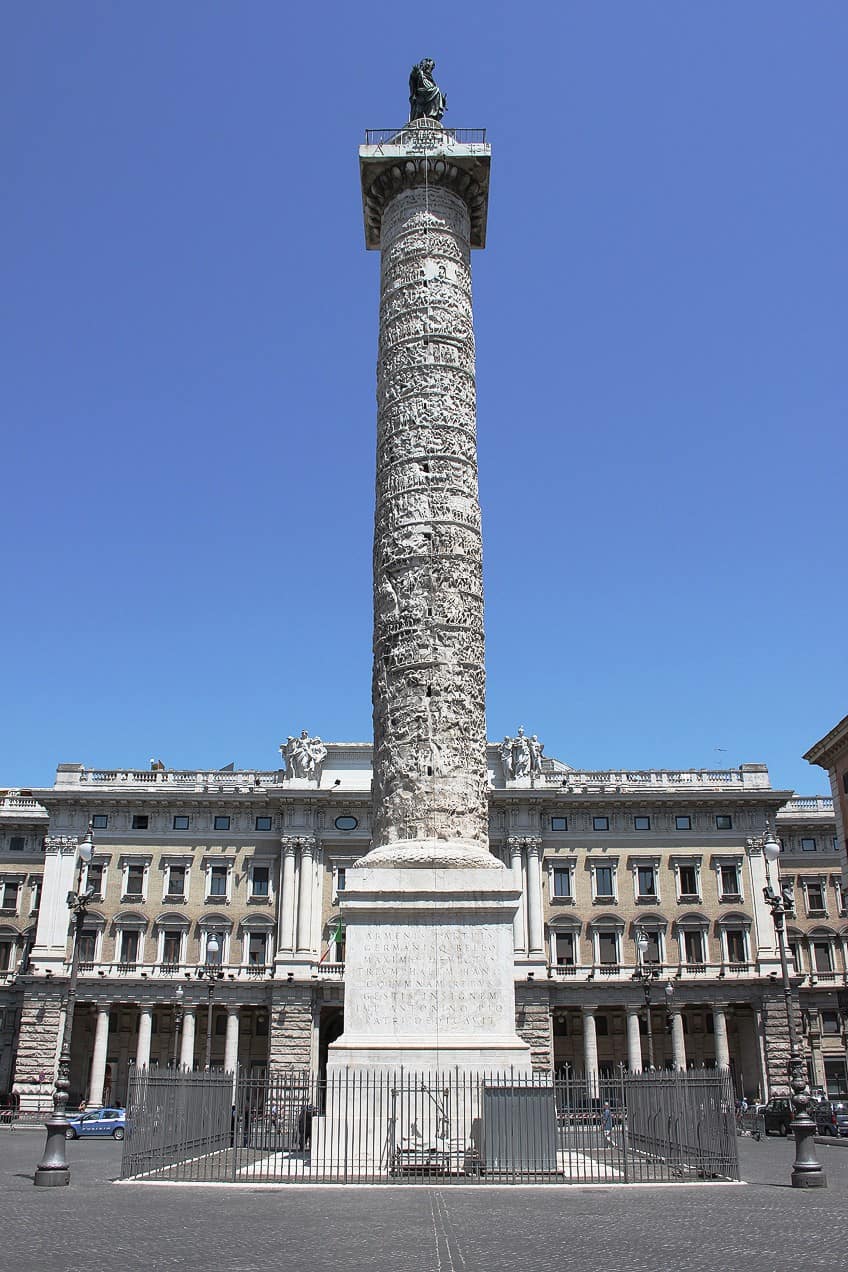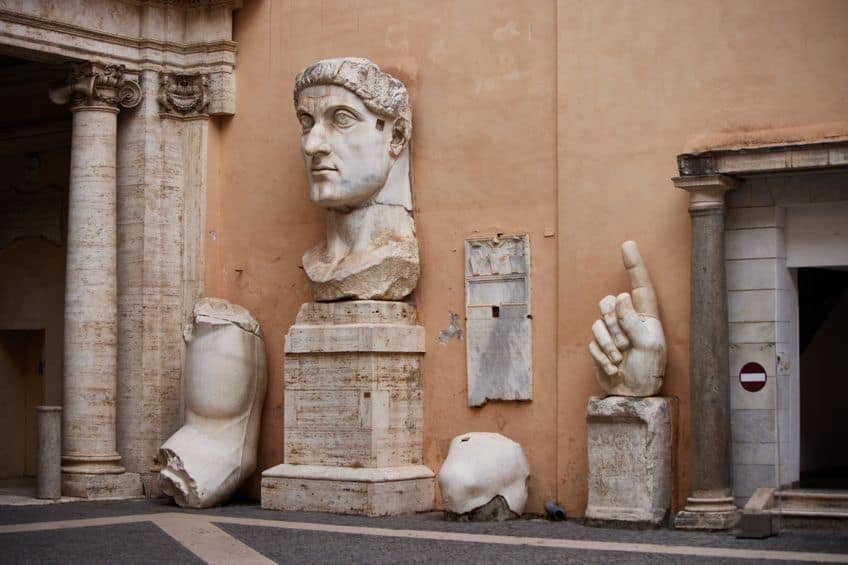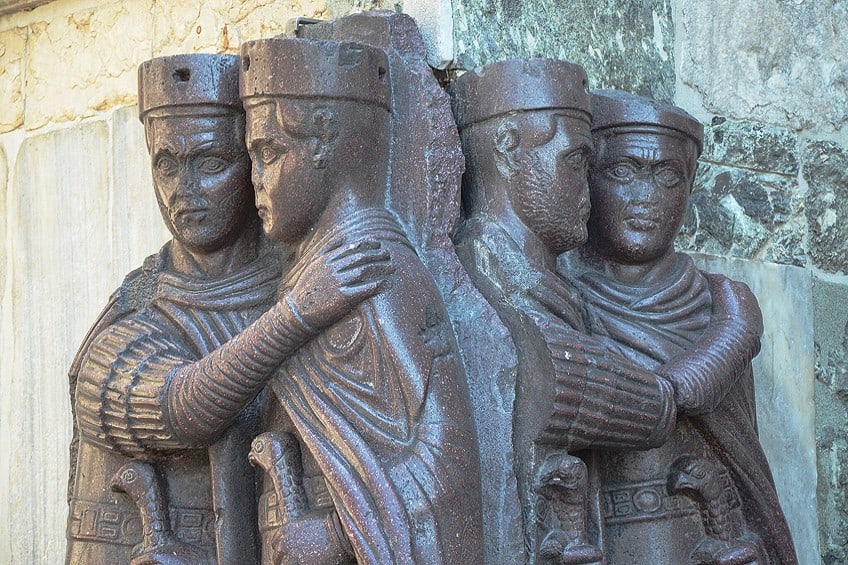Roman Artifacts – A Glimpse into Ancient Rome
Roman artifacts come in many different shapes and sizes. There are various ancient Roman antiques, artworks, and other artifacts to explore from this ancient and long-lasting civilization. So, if you want to learn a lot more about a few of these Roman artifacts, along with some of their history and characteristics, then keep reading to learn all about them!
A Look at Roman Artifacts
Below we will have a look at ten different Roman artifacts. Some of them are Roman antiques, some of them are large mosaics, and others are something else entirely. Keep reading to learn a lot more about these ancient Roman artifacts and why they are so well known today.

Leaping Dolphins Mosaic in House of Dolphins (120 – 80 BCE)
| Created | 120 – 80 BCE |
| Materials Used | Mosaic |
| Function | Floor mosaic |
| Discovery Location | Delos, Greece |
The Leaping Dolphins Mosaic in the House of Dolphins is a somewhat terrifying sight and also one of the most Ancient Roman artifacts. It is a Roman-era floor mosaic that can be found in the House of Dolphins in Delos, Greece. This is an example of a truly ancient Roman artifact. It is an artwork that depicts several rather terrifying leaping dolphins as they stare at you with their yellow eyes and black and white teeth.
These are actually somewhat indicative of the kinds of dolphins that the Romans often used in their iconography.
This particular floor mosaic depicts Eros, the Greek god of erotic love, as he rides these dolphins to wherever he’s going. This particular divine figure would essentially have its Roman counterpart in the perhaps more famous Cupid. However, the leaping dolphin motifs are the most striking image on this particular floor mosaic, and they are quite distinct from the sorts of dolphins that were depicted by the Greeks. Their dolphins weren’t quite as horrifying as these, but perhaps the Romans simply saw dolphins as far scarier creatures than we see them today.
Alexander Mosaic (100 BCE)
| Created | 100 BCE |
| Materials Used | Mosaic |
| Function | Floor mosaic |
| Discovery Location | Pompeii, Italy |
The Alexander Mosaic is another floor mosaic, but this one does not include any terrifying leaping dolphins. Instead, the Alexander Mosaic depicts the grand battle that took place between Darius III of Persia and the famed Ancient Greek conqueror Alexander the Great. This scene may have been an imitation of a similar image by either Philoxenus of Eretria (4th Century BCE) or Apelles (4th Century BCE). Either way, the current Alexander Mosaic is a fascinating example of ancient Roman artifacts as it exemplifies a combination of styles. There are Italic, Roman, and Hellenistic features within this floor mosaic.

The original mosaic, which is 2.73 m by 5.13 m (or 8 ft 11 in x 16 ft 10 in) is preserved in its original form in the Naples National Archaeological Museum. So, you can now visit the mosaic and its composite parts, which are comprised of over one and a half million individual tiles that had to be found in the natural environment as the Romans lacked the ability to color them at the time. This is also why this mosaic is something of a mystery despite being such a famous artifact. Something of this scale and intricacy was found in a private residence rather than a public or imperial location, so it must have been an immensely wealthy individual who was able to pay for such a detailed work.
Great Cameo of France (23 or 50 – 54 CE)
| Created | 23 or 50 – 54 CE |
| Materials Used | Onyx |
| Function | Cameo |
| Discovery Location | Somewhere in the Byzantine Empire |
The Great Cameo of France is one of the most famous cameos in existence. This cameo makes use of a five-layered style built over sardonyx, and while it is very small, it’s also one of the most famous Roman artifacts in existence. It is only 31 cm by 26.5 cm (or 12.2 in by 10.43 in) but it is still the largest of its kind to have survived through the ages. This important Roman artifact was obviously an immensely valuable item and it would have been owned by a royal member, and in this case, it was likely a member of the Julio-Claudian dynasty.
The cameo itself is made up of 24 carved figures over three distinct levels, and there has been much debate about the identity of some of these figures.
However, it has been determined that it was intended as a means of preserving the dynasty that held onto it. Such a gorgeous Roman artifact eventually fell into the hands of the French rulers, who had received it from the treasury of the Byzantine Empire, and it then finally made its way to its present home in the Bibliothèque Nationale in Paris.

Augustus of Prima Porta (1st Century CE)
| Created | 1st Century CE |
| Materials Used | White marble |
| Function | Portrait statue |
| Discovery Location | Rome, Italy |
Augustus of Prima Porta is a portrait statue that stands at full height, and it depicts Augustus Caesar at his 2.08 m (or 6 ft 10 in) height, but unlike a person of that size, it weighs about 1,000 kg (or 2,200 lb). This statue was actually discovered during some excavations of the Villa of Livia, which had been owned by Augustus’s third wife. The statue became an immediate sensation and is likely one of, if not the most, famous Roman artifact.

The statue was carved by Greek sculptors, and it is now assumed that this piece is simply a copy of a long-lost bronze statue of Augustus Caesar that was once located in Rome. The statue is structured in such a way that Augustus is holding his hand out in a commanding pose, known as the adlocutio pose while addressing his troops. This was a fairly typical way to depict the most powerful men in this society as it showed their authority in the gestures that they adopted.
Column of Antoninus Pius (161 CE)
| Created | 161 CE |
| Materials Used | Red granite |
| Function | Honorific column |
| Discovery Location | Rome, Italy |
The Column of Antoninus Pius is an honorific column that was dedicated to Antoninus Pius. It was established by those who came after him, Marcus Aurelius and Lucius Verus, and it stood at a height of 14.75 m (or 48.4 ft). So, it was a large column, and it was made out of red granite, but the column itself no longer exists aside from the base. It also had to withstand several centuries of being buried, but it was eventually discovered, and the nearby area was excavated to bring it to the surface.
The base of this honorific column is decorated with two important funerary rituals.
One side shows the decursio, which was a military ceremony performed by the cavalry), and the other side depicts an apotheosis, or ascent to the gods. This should be a good indication that this particular ruler was loved enough that his successors were willing to commemorate him with funerary depictions of this kind.

Equestrian Statue of Marcus Aurelius (175 CE)
| Created | 175 CE |
| Materials Used | Bronze |
| Function | Equestrian statue |
| Discovery Location | Rome, Italy |
The Equestrian Statue of Marcus Aurelius is a statue of Marcus Aurelius, the emperor and philosopher, atop his horse. The sculpture is made of bronze, and remains one of the most famous Roman artifacts, likely because of its association with one of the most famous Roman emperors. The statue stands at 4.24 m (or 13.9 ft) and it does not project particularly realistic proportions. It is larger than life and very much meant to be.

The statue is a little different from some Roman statues of a similar kind. It does not include the same kind of militaristic fervor that some of the other statues of this variety entail. Marcus Aurelius saw himself more as a bringer of peace rather than a military commander, and so his depiction without weapons or armor is possibly meant to signify the more peace-oriented approach that he aimed to possess.
Column of Marcus Aurelius (Between 176 – 193)
| Created | Somewhere between 176 – 193 |
| Materials Used | Marble |
| Function | Victory column |
| Discovery Location | Rome, Italy |
The Column of Marcus Aurelius is a victory column that is highly ornate in its overall depiction, and it is strongly modeled after the similarly designed Trajan’s Column. However, this particular column was designed with a Doric design and a spiraled relief that descends from the top of the structure to the bottom. The original inscription on the column was destroyed at some point, so it can be difficult to know when exactly it would have been constructed, but it was either built during Marcus Aurelius’ death or shortly after it.

The column is 26.6 m (or 97 ft) tall, but the height is even larger because the column stands atop a 10.1 m (or 33 ft) base which, to further add to the height, was originally built on top of a 3 m (or 9.8 ft) platform. This means that they definitely wanted to make sure that this particular column, and its vast array of pictorial images of Marcus Aurelius’ victories, could be seen from afar.
Colossus of Constantine (312 – 315 CE)
| Created | 312 – 315 CE |
| Materials Used | Marble, wood, and brick |
| Function | Colossal statue |
| Discovery Location | Rome Italy |
The Colossus of Constantine is a colossal statue, as the name may suggest, and it once stood at about 12 m (or 40 ft) in height. These days, this ancient Roman artifact does not look as good as it once did. Instead, it has mostly fallen apart into literal pieces. The head, limbs, and legs of this once-tall colossal statue were made of white marble, but because of its size, it used a brick core and a wooden framework. This division of materials allowed for it to be as massive as it was, but it also meant that it was more likely to collapse with age.
An interesting feature of this colossal statue is the use of the Constantinian style that had become more widely adopted at the time.
This style was far more naturalistic and would even include biological issues like protruding veins and callused feet. However, that focus on the actual body without any additional elaboration did allow for it to aim towards a more transcendent view of ascendance. This was the earthly body that was to be left behind after death, after all.

Portrait of the Four Tetrarchs (Around 300 CE)
| Created | Around 300 CE |
| Materials Used | Porphyry |
| Function | Sculpture |
| Discovery Location | Venice, Italy |
The Portrait of the Four Tetrarchs is a sculpted group of figures that have been identified as the four Roman emperors of the Tetrarchy. This political setup entailed a four-ruler system within Rome in which two higher and two lower rulers had power over each other, and it was a way to ensure that there was never a dictator. However, it did eventually fall away.

This particular sculpture may be a depiction of this Tetrarchy political system, but there are other arguments about who is depicted here. Either way, the figures are not particularly in line with much of earlier Roman art as the figures are rather blocky and rigid. There’s a lack of expressiveness in the faces too. This is why this sculpture has been used to argue for the decline of the Roman Empire during this later period. Either way, it is still one of the most famous Roman artifacts in the world.
Lycurgus Cup (4th Century CE)
| Created | 4th century CE |
| Materials Used | Dichroic glass |
| Function | Glassware |
| Discovery Location | Rome, Italy |
The Lycurgus Cup is an example of one of the many Roman antiques that have made their way into the world over the centuries. This particular glass cup is a particularly interesting one because it makes use of dichroic glass. This means that the cup actually changes color depending on whether or not there’s light passing through it. It can be red or green depending on the light, and it is also the only complete Roman glass object that was made using this type of glass.

It is also encased in a decorative design that only stands at about 16.5 cm (or 6.54 in) in height. Regardless of its smaller stature, this Roman artifact is a phenomenal and well-preserved example of the kind of developments that they were capable of achieving. However, we do not entirely know how they achieved the dichroic effect, and it’s possible that it was done by mistake. We will likely never know though.
We have come to the end of our discussion about Roman artifacts. We have looked at several ancient Roman artifacts and Roman antiques to see the kind of artistry that the Roman civilization was capable of mustering. Hopefully, this article has been informative about Roman artifacts and has given a few interesting instances of this culture’s artistic creations. So, we hope you have a great day/week/month ahead!
Frequently Asked Questions
What Is a Roman Artifact?
An artifact is anything of particular interest from a period or civilization. In the case of Roman artifacts, these would be any items or pieces of art that, in some way, exemplify an aspect of that culture. There are many ancient Roman artifacts in the world, and they are all important pieces of the collective history of the planet.
When Was the Roman Civilization?
Rome officially started with the founding of Rome itself in the 8th century BCE. The Roman civilization would then transition through various periods, the Kingdom, Republic, and finally the Empire, but it would all end in the 5th century when the Western Roman Empire collapsed. However, it did remain in some form through the Byzantine Empire and the Holy Roman Empire that would follow it.
What Is the Most Famous Roman Artifact?
There are many famous Roman artifacts. While the Romans are likely better known for their extensive architectural triumphs, it could be argued that something like the Augustus of Prima Porta statue is the most famous Roman artifact. This statue has become synonymous with Rome in the same way that many Roman architectural achievements have over the centuries.
Jordan Anthony is a Cape Town-based film photographer, curator, and arts writer. She holds a Bachelor of Art in Fine Arts from the University of the Witwatersrand, Johannesburg, where she explored themes like healing, identity, dreams, and intuitive creation in her Contemporary art practice. Jordan has collaborated with various local art institutions, including the KZNSA Gallery in Durban, the Turbine Art Fair, and the Wits Art Museum. Her photography focuses on abstract color manipulations, portraiture, candid shots, and urban landscapes. She’s intrigued by philosophy, memory, and esotericism, drawing inspiration from Surrealism, Fluxus, and ancient civilizations, as well as childhood influences and found objects. Jordan is working for artfilemagazine since 2022 and writes blog posts about art history and photography.
Learn more about Jordan Anthony and about us.
Cite this Article
Jordan, Anthony, “Roman Artifacts – A Glimpse into Ancient Rome.” artfilemagazine – Your Online Art Source. October 26, 2023. URL: https://artfilemagazine.com/roman-artifacts/
Anthony, J. (2023, 26 October). Roman Artifacts – A Glimpse into Ancient Rome. artfilemagazine – Your Online Art Source. https://artfilemagazine.com/roman-artifacts/
Anthony, Jordan. “Roman Artifacts – A Glimpse into Ancient Rome.” artfilemagazine – Your Online Art Source, October 26, 2023. https://artfilemagazine.com/roman-artifacts/.



